黄埔军校校训――亲爱精诚PPT课件
- 格式:ppt
- 大小:3.47 MB
- 文档页数:13
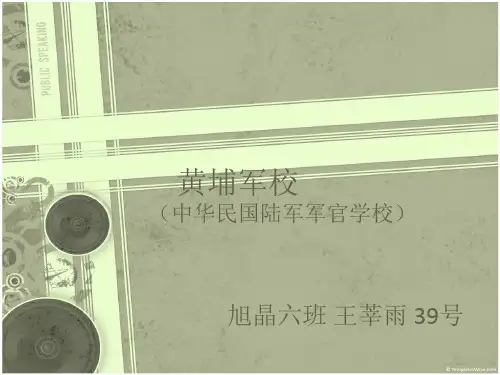

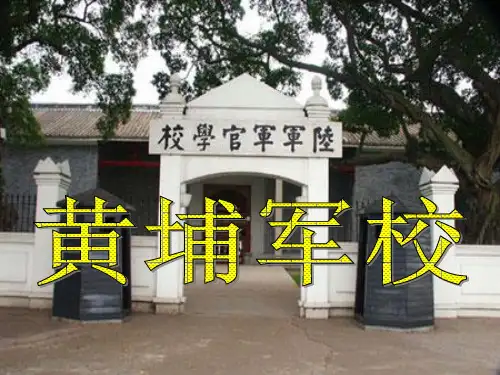
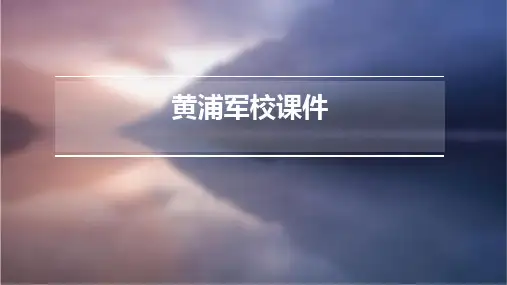
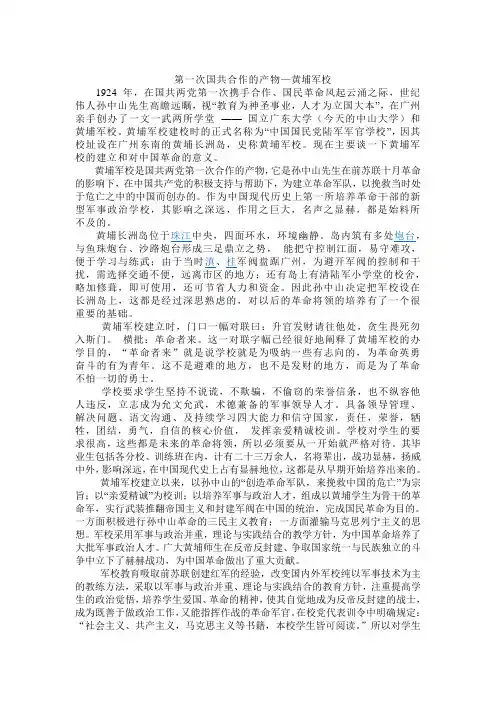
第一次国共合作的产物—黄埔军校1924 年,在国共两党第一次携手合作、国民革命风起云涌之际,世纪伟人孙中山先生高瞻远瞩,视“教育为神圣事业,人才为立国大本”,在广州亲手创办了一文一武两所学堂——国立广东大学(今天的中山大学)和黄埔军校。
黄埔军校建校时的正式名称为“中国国民党陆军军官学校”,因其校址设在广州东南的黄埔长洲岛,史称黄埔军校。
现在主要谈一下黄埔军校的建立和对中国革命的意义。
黄埔军校是国共两党第一次合作的产物,它是孙中山先生在前苏联十月革命的影响下,在中国共产党的积极支持与帮助下,为建立革命军队,以挽救当时处于危亡之中的中国而创办的。
作为中国现代历史上第一所培养革命干部的新型军事政治学校,其影响之深远,作用之巨大,名声之显赫,都是始料所不及的。
黄埔长洲岛位于珠江中央,四面环水,环境幽静。
岛内筑有多处炮台,与鱼珠炮台、沙路炮台形成三足鼎立之势,能把守控制江面,易守难攻,便于学习与练武;由于当时滇、桂军阀盘踞广州,为避开军阀的控制和干扰,需选择交通不便,远离市区的地方;还有岛上有清陆军小学堂的校舍,略加修葺,即可使用,还可节省人力和资金。
因此孙中山决定把军校设在长洲岛上,这都是经过深思熟虑的,对以后的革命将领的培养有了一个很重要的基础。
黄埔军校建立时,门口一幅对联曰:升官发财请往他处,贪生畏死勿入斯门。
横批:革命者来。
这一对联字幅已经很好地阐释了黄埔军校的办学目的,“革命者来”就是说学校就是为吸纳一些有志向的,为革命英勇奋斗的有为青年。
这不是避难的地方,也不是发财的地方,而是为了革命不怕一切的勇士。
学校要求学生坚持不说谎,不欺骗,不偷窃的荣誉信条,也不纵容他人违反,立志成为允文允武,术德兼备的军事领导人才。
具备领导管理、解决问题、语文沟通、及持续学习四大能力和信守国家,责任,荣誉,牺牲,团结,勇气,自信的核心价值,发挥亲爱精诚校训。
学校对学生的要求很高,这些都是未来的革命将领,所以必须要从一开始就严格对待。
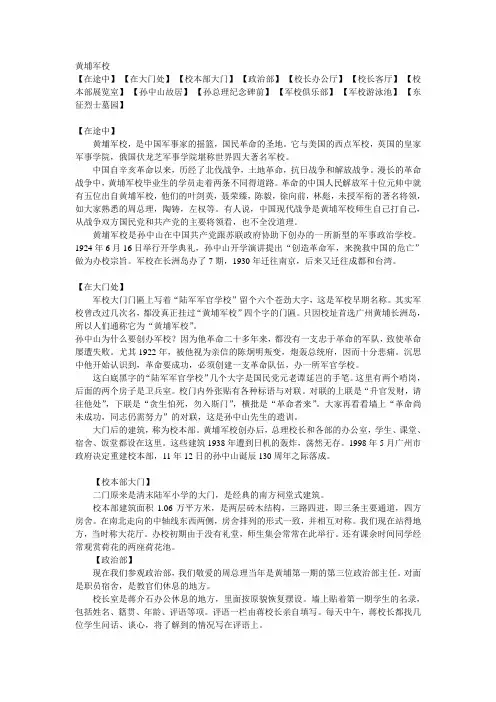
黄埔军校【在途中】-【在大门处】-【校本部大门】-【政治部】-【校长办公厅】-【校长客厅】-【校本部展览室】-【孙中山故居】-【孙总理纪念碑前】-【军校俱乐部】-【军校游泳池】-【东征烈士墓园】【在途中】黄埔军校,是中国军事家的摇篮,国民革命的圣地。
它与美国的西点军校,英国的皇家军事学院,俄国伏龙芝军事学院堪称世界四大著名军校。
中国自辛亥革命以来,历经了北伐战争,土地革命,抗日战争和解放战争。
漫长的革命战争中,黄埔军校毕业生的学员走着两条不同得道路。
革命的中国人民解放军十位元帅中就有五位出自黄埔军校,他们的叶剑英,聂荣臻,陈毅,徐向前,林彪,未授军衔的著名将领,如大家熟悉的周总理,陶铸,左权等。
有人说,中国现代战争是黄埔军校师生自己打自己,从战争双方国民党和共产党的主要将领看,也不全没道理。
黄埔军校是孙中山在中国共产党跟苏联政府协助下创办的一所新型的军事政治学校。
1924年6月16日举行开学典礼,孙中山开学演讲提出“创造革命军,来挽救中国的危亡”做为办校宗旨。
军校在长洲岛办了7期,1930年迁往南京,后来又迁往成都和台湾。
【在大门处】军校大门门匾上写着“陆军军官学校”留个六个苍劲大字,这是军校早期名称。
其实军校曾改过几次名,都没真正挂过“黄埔军校”四个字的门匾。
只因校址首选广州黄埔长洲岛,所以人们通称它为“黄埔军校”。
孙中山为什么要创办军校?因为他革命二十多年来,都没有一支忠于革命的军队,致使革命屡遭失败。
尤其1922年,被他视为亲信的陈炯明叛变,炮轰总统府,因而十分悲痛。
沉思中他开始认识到,革命要成功,必须创建一支革命队伍,办一所军官学校。
这白底黑字的“陆军军官学校”几个大字是国民党元老谭延岂的手笔。
这里有两个哨岗,后面的两个房子是卫兵室。
校门内外张贴有各种标语与对联。
对联的上联是“升官发财,请往他处”,下联是“贪生怕死,勿入斯门”,横批是“革命者来”。
大家再看看墙上“革命尚未成功,同志仍需努力”的对联,这是孙中山先生的遗训。
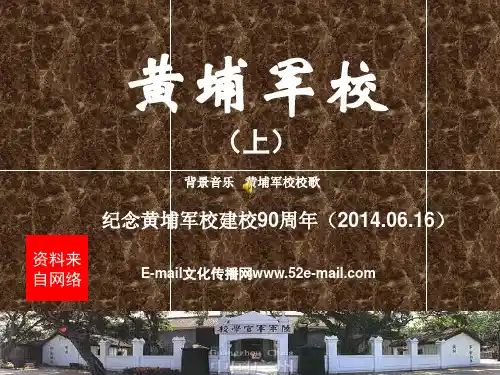
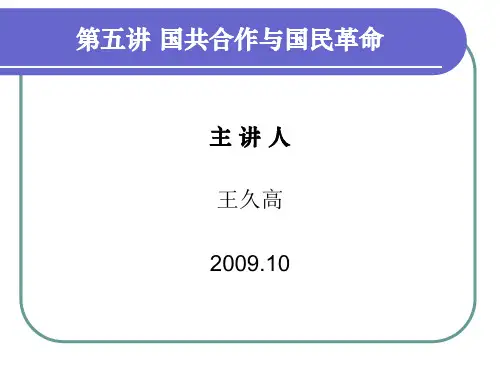

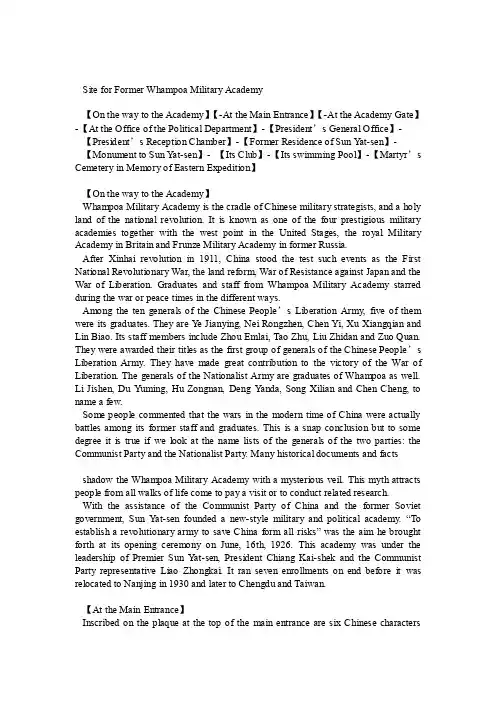
Site for Former Whampoa Military Academy【On the way to the Academy】【-At the Main Entrance】【-At the Academy Gate】-【At the Office of the Political Department】-【President’s General Office】- 【President’s Reception Chamber】-【Former Residence of Sun Y at-sen】- 【Monument to Sun Y at-sen】- 【Its Club】-【Its swimming Pool】-【Martyr’s Cemetery in Memory of Eastern Expedition】【On the way to the Academy】Whampoa Military Academy is the cradle of Chinese military strategists, and a holy land of the national revolution. It is known as one of the four prestigious military academies together with the west point in the United Stages, the royal Military Academy in Britain and Frunze Military Academy in former Russia.After Xinhai revolution in 1911, China stood the test such events as the First National Revolutionary War, the land reform, War of Resistance against Japan and the War of Liberation. Graduates and staff from Whampoa Military Academy starred during the war or peace times in the different ways.Among the ten generals of the Chinese People’s Liberation Army, five of them were its graduates. They are Y e Jianying, Nei Rongzhen, Chen Yi, Xu Xiangqian and Lin Biao. Its staff members include Zhou Emlai, Tao Zhu, Liu Zhidan and Zuo Quan. They were awarded their titles as the first group of generals of the Chinese People’s Liberation Army. They have made great contribution to the victory of the War of Liberation. The generals of the Nationalist Army are graduates of Whampoa as well. Li Jishen, Du Yuming, Hu Zongnan, Deng Y anda, Song Xilian and Chen Cheng, to name a few.Some people commented that the wars in the modern time of China were actually battles among its former staff and graduates. This is a snap conclusion but to some degree it is true if we look at the name lists of the generals of the two parties: the Communist Party and the Nationalist Party. Many historical documents and facts shadow the Whampoa Military Academy with a mysterious veil. This myth attracts people from all walks of life come to pay a visit or to conduct related research.With the assistance of the Communist Party of China and the former Soviet government, Sun Y at-sen founded a new-style military and political academy. “To establish a revolutionary army to save China form all risks” was the aim he brought forth at its opening ceremony on June, 16th, 1926. This academy was under the leadership of Premier Sun Y at-sen, President Chiang Kai-shek and the Communist Party representative Liao Zhongkai. It ran seven enrollments on end before it was relocated to Nanjing in 1930 and later to Chengdu and Taiwan.【At the Main Entrance】Inscribed on the plaque at the top of the main entrance are six Chinese characters“陆军军官学校”(General Academy of Army), written by Tan Y ankai, the patriarch of the Nationalist Party. The academy was renamed for a few times, but they never put the four Chinese character “黄埔军校”on the plaque. It is called so just because it was located at Whampoa, in Changzhou Island, Guangzhou.Now we come back to the topic why Sun Yat-sen wanted to found a military academy? He devoted himself to the national revolution for more than two decades, but he did not have an army loyal to the revolution. This led to the failure in revolution from time to time, he concluded. He felt extremely sad in 1922 when Chen Jiongmin betrayed him and bombarded the Office of the President. After deep refection, he was determined to establish a general academy of army to cultivate leading generals and well-trained soldiers in order to succeed in the revolution. Mottos and couplets were posted inside the Academy. We can find the last words of Premier Sun Y at-sen here: “The work of revolution is not yet done, let all our comrades strive for its success.”Behind the main entrance is the site of the academy. It used to be the Canton Army Primary School in the late Qing Dynasty. After the Academy was established, the president’s office, departments’offices, classrooms, dormitories and the dining hall were all here. But all the buildings on the campus were destroyed by Japanesefighter planes in 1938. It was really a pity. In May, 1998, Guangzhou municipal government decided to have the academy rebuilt. Its reconstruction cost more than 20 million yuan. It was completed on November 12th, in 1998 when it was the 130th anniversary of Premier Sun Y at-sen.【At the Academy Gate】The Academy covers an area of 10,600 square meters .Its two-storey school board buildings are brick-timber framed. Three main passages and four rows of housing buildings are its layout.The four rows of housing buildings have the same design and stand symmetrically on either the east or the west side of an invisible north-south axis. Surrounded by walls, these four buildings lead onto the main passages. As we can see, the buildings on the campus are linked into a complete whole by passages. We can also feel its quietness and grace.The place we are now standing at was called “Dahua Hall”. It was the meeting place of its staff members and students when the academy was just set up and they did not have auditorium.【At the Office of the Political Department】We are now visiting the office of the Political Department. Premier Zhou Enlai worked as the third director of this Department when they had their first enrollment. Marshal Nie Rongzhen acted as secretary for this Department, and he worked as a drill master as well.President’s Chamber is the room where President Qiang Kai-shek used to work and rest. The furnishings in the room are displayed according to their original arrangementwhen he was here. On the walls is name list of their first enrolled students, including their name, birth place, ages and comment column. President is the person who makes the comment in the column. He once wrote about Chen Gen like this: “This graduate looks weak, but he is poised and hardworking. He is qualified to lead his men.” From the comments he made, we cold infer that President QiangKai-shek is a careful observer of the students’personality, ability and strong points.【President’s General Office】Now we are entering President’s General Office. Nationalist Party’s representative, Liao Zhongkai, worked here. As the Party’s patriarch and great contributor to the Xinhai Revolution, he dedicated himself to the establishment of the Academy by taking concurrent posts. When the school had financial difficulties, he spared no effort to raise funds to get through. He assured his colleagues, “Please don’t worry about our financial situation, I’ll be responsible for it. Y ou are shouldered with the responsibility to train and nurture ou r students.” His devotedness won him the title “a motherly affectionate leader of the party and the army.”【President’s Reception Chamber】The couplet in the President’s Reception says, “Climb the hills to see the sea afar, ride on the horse to pacify China”. It was written by the famous calligrapher and the Nationalist Party’s Patriarch Yu Y ouren and was presented to President Chiang Kai-shek. The structure of the couplet in Chinese is symmetrical. Its wording is vigorous. This couplet expresses the ambition and firm determination of the staff and students to reunify China, with this academy as their solid base.【The Former Residence of Sun Y at-sen】The two-storey building combines the Chinese and western architectural styles. It was used as a customs house during the Qing Dynasty. In 1952 when this building was under repair, the wooden staircase in the west was made indoors. The exhibits were organized into the themes of “The Old Days of this Storied Building” and “Anecdotes of Sun-Mei”. We can see some pictures, and some physical objects. From the exhibits here, we can know more about the past glory of the acade my, and the friendship between Sun Y at-sen and his Japanese friend, Umeya Shakichi.【Monument to Sun Yat-sen】This monument was built in 1928 and completed in 1930. It can be said that its shape and design is distinctive. Viewed from afar, a huge Chinese character “文”is eye-catching.“文”is the focus of the whole thing. Why so? As you know, “文”is the name given by his parents when he was born.The base of the monuments is massive. Four striking Chinese characters “亲爱精诚”are written there, emphasizing the qualities of “love and sincerity”. This four-word text is the motto of the Military Academy. This base consists of two parts, separating by a passage. The lower part implies a figure of seven. It symbolizes the sevenenrollments the Military Academy has had in Whampoa. The upper part implies a figure of five. It refers to the five battles its staff and students waged successfully. Please look up at the statue of Sun Y at-sen. He was concentrating himself in lecturing his Three Principles of the People, wasn’t he?This bronze statue is 3.9 meters in height and 1 ton in weight. It was donated by his Japanese friend, Umeya Shakichi, who entrusted this work to a Japanese sculptor (牧田祥哉). As Umeya was in financial difficulty at that time, he had four identical statues made only. The other three were placed respectively in Sun Y at-sen University in Guangzhou, Sun Y at-sen Mausoleum in Nanjing, and Sun Y at-sen Memorial in Macau.Under the foot of the statue, we can see Chinese characters inscribed on the four sides of the monument. On its front facade is “孙总理纪念碑”,the handwritings of a famous calligra pher, called Hu Hanming. Its equivalent in English is “Dedicated to Premier Sun”. On its back are the words, depicting him a man as he is. These words are used as the oaths of his comrades when they go on with the work he left unfinished. On its eastern si de are“和平、奋斗、救中国”(For Peace, to Struggle and Save China).On its western side is the exhortation of Premier Sun. These words have been encouraging, inciting and advising earnestly his comrades and later generations. His exhortation was adopted as national anthem after Nationalist Party settled its capital in Nanjing 1927.【Its Club】This two-storey building, quite a grand hall at that time, was completed in 1926. It holds more than one thousand people. The Academy often had their gatherings, presentations, celebrations, and entertaining performance here in this auditorium. 【Its Swimming Pool】Most of the students were from the northern part of China. They couldn’t swim. This could be a drawback. Two docks nearby were transformed into swimming pools. They first learned how to swim in the pools, then went to swim in the Pearl River. This training prepared the enrolled students to fight in the southern part of China where water networks were formed.【Marty’s Cemetery in Memory of Eastern Expedition】This cemetery was built in 1925, completed one year later. Its design is similar to Cemetery for 72 martyrs at Huanghuagang, Guangzhou.This cemetery was built in memory of 516 martyrs who lay down their life on the two Eastern Expeditions in 1925. Among those heroes, Liu Y aozhan was of the highest rank. He was promoted to Lieutenant General after his death.On its west lies the cemetery for their 16 generals. Inscribed there are the nine Chinese characters read like“东征阵亡烈士纪念坊”. Its equivalent of English is “Dedicated to the Martyrs on Eastern Expeditions”. They are the handwritings of Zhang Renjie. His other name is Zhang Jingjiang. He is the patriarch of the Nationalist Party, the military counselor and the teacher of Chiang Kai-shek. He wasone of the three most famous calligraphers serving for the Nationalist Party. Eastward Walk brings us to the cemetery of Cai Guangju. Born in Zunyi, Gunzhou, he was a student in the list of the first enrollment of the Academy. On the Eastern Expedition, he died in Danshui. Due to his bravery and his high ranking among the graduates, he earned this honour to have his own cemetery.Monument to Northern Expedition was erected in 1929 to remember those who sacrificed their life in the battles on their Northern Expedition. It is 7 meters high.There are inscriptions on the three sides of the base. “Dedicated to the Graduates of the General Academy of Army who served as Generals and Lieutenants, but sacrificed on the Northern Expedition” are the characters written on its front facade. “Sacrifice for the Motherland” are on its east side while “Sacrifice for the People” are on its west. The names of 353 martyrs who were graduates of the Academy are inscribed on the northern, eastern and western sides.Their noble spirit of revolution are unceasingly inspiring later generations.黄埔军校旧址【在途中】——【在大门处】——【校本部大门】——【政治部】——【校长办公厅】——【校长会客厅】——【孙中山“故居”】——【孙总理纪念碑前】——【军校俱乐部】——【军校游泳池】——【东征烈士墓园】【在途中】黄埔军校,是中国军事家的摇篮,国民革命的圣地。

黄埔军校简介1921年(辛酉年)12月,共产国际代表马林在广西桂林会见孙中山,马林向孙中山提出“创办军官学校,建立革命军”的建议。
1924年1月中国国民党第一次全国代表会议决议建立军官学校选址于广州黄埔。
关于校长人选,最初决定为程潜,而以蒋介石、李济深为副校长。
但是蒋介石不愿在程潜之下,跑到上海消极对抗。
并派张静江找孙中山说情,孙中山才在5月3日任命蒋介石为校长。
在此过程中,蒋介石曾辞去军校筹备委员长一职。
对其原因许多学者进行了探讨,除众所公认的财政问题外,蒋介石辞职的深层次原因是对广东政局的现状,尤其是对自己在国民党改组以后未能得到相当的地位和权力强烈不满。
“蒋对一些革命的根本问题,如联俄、联共等,思想上有保留,又不宜公开说出,便在行动上采取消极态度。
”蒋介石辞职“有不满意职位低微的原因,也有玩弄‘以退为进’的政治权术的意味。
军校成立后,以蒋介石为校长,廖仲恺为国民党党代表。
随后,任李济深、邓演达为教练部正、副主任,王柏龄、叶剑英为教授部正、副主任;戴季陶(后为周恩来)、周恩来为政治部正、副主任,何应钦为总教官。
此外还有熊雄、恽代英、萧楚女、聂荣臻、张秋人等共产党人担任教官及各方面负责工作。
1924年5月,从1200名考生中正式取录学生350名,备取120名。
5月5日开始入学。
6月16日,举行陆军军官学校开学典礼,孙中山到会场给青年作了热情洋溢的讲话:“要从今天起,立一个志愿,一生一世,都不存在升官发财的心理,只知道做救国救民的事业。
”孙中山还宣布训词:“三民主义,吾党所宗,以建民国,以进大同,咨尔多士,为民前锋,夙夜匪懈,主义是从,矢勤矢勇,必信必忠,一心一德,贯彻始终”,此训词其后成为国民党党歌及官校校歌,并由陈祖康谱曲,该校歌从黄埔五期开始传唱至今。
1925年1月25日,黄埔军校成立“青年军人社”廖仲恺任社长,2月1日该社刊物《青年军人》第一期出版。
黄埔军校最初有许多从苏联来的教员,但在北伐战争期间蒋中正与中国共产党关系破裂,所以这些苏联教员离开了。